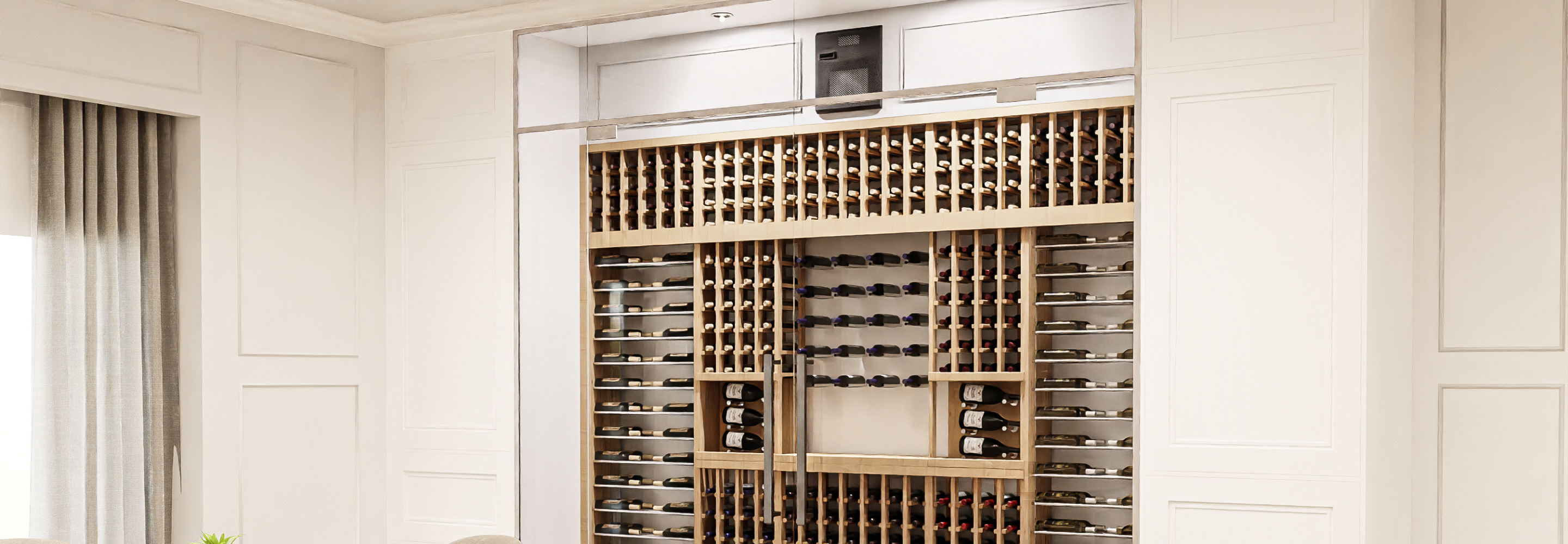A STYLE-BY-STYLE GUIDE TO WINE CELLAR COOLING UNIT INSTALLATION
For any collector, a cellar is not just a place to store wine. A wine cellar should be an optimized environment to house your valuable collection while each bottle ages to its fullest potential. Wine cellar cooling units regulate the proper temperature and humidity for optimal wine storage, protecting your investment for years to come. Wine cellar cooling unit installation can vary depending on the type of unit being installed. Some can safely be installed by nearly any homeowner, while others must be installed by a certified HVAC contractor. This article explores the differences between through-wall, split and ducted systems, and offers some advice on how to install a wine cellar cooling unit.
THE IMPORTANCE OF WINE CELLAR COOLING UNITS & PROPER WINE CELLAR COOLING UNIT INSTALLATION
Installing a wine cellar cooling unit will help create a consistent, ideal temperature in which to age your wine to its peak bouquet. The ideal temperature for storing wine is 55 degrees Fahrenheit. So long as the wine is held within 3-4 degrees of that, it will be able to maintain its quality for years on end. Anything warmer will allow the wine to age too quickly, and anything cooler will slow the aging process down.
In addition to maintaining the ideal temperature for aging wine, installing a wine cellar cooling unit will also maintain the proper humidity (between 50-70%) needed for sustaining healthy corks. Corks, when properly hydrated, allow only minimal oxygen into the bottle each year, which reacts with the tannins and sulfates to eventually help the bottle blossom into a perfect vintage. If stored in a cellar that is too dry, the cork will dry out, allowing more oxygen to enter the bottle, which can lead to wine evaporation and spoilage. On the other hand, in a cellar that is too humid, accumulated moisture on the corks can lead to mold growth, which also completely ruins the wine.
A properly installed wine cellar cooling unit solves these problems by regulating the temperature and humidity in your cellar. Even in homes and businesses with central A/C units, daily changes in the temperature and humidity can wreak havoc on the quality and longevity of your wines. A wine cellar cooling unit creates a stable environment.
specifically tailored for protecting your wines while they age. Proper wine cellar cooling unit installation not only means selecting the right unit for your particular space. It also means ensuring the unit has been installed so that it will function correctly, creating the ideal environment to house your wine collection.
INSTALLING THROUGH-WALL SYSTEMS
Through-wall cellar cooling units are all-in-one, self-contained systems that are mounted between the studs of an existing wall. They circulate air throughout the cellar and exhaust heat out the back into an adjacent space. You can vent through-wall units to the outdoors, if you opt for an exterior-grade unit. The most cost-effective option for most collectors, through-wall units need less space than split systems but maintain an ideal aging environment for spaces of about 100-2,000 cubic feet. Through-wall wine cellar cooling unit installation is fairly easy and can be done by nearly any semi-industrious DIYer or homeowner.
STEP 1: CREATE AN OPENING FOR THE UNIT
To install a through-wall system, you first need to cut a hole big enough to accommodate your unit in the wall. Most of our units are designed to fit between 16-inch studs; however, bigger units may require building out a frame, within the wall, to accommodate the unit. A 2 foot by 4 foot frame is then built around the existing hole to support the weight of the unit and reinforce the wall’s structural integrity.
STEP 2: FRAME OUT THE VENT AND ADD SUPPORTING SHELVING
Before hanging a through-wall unit, a finished frame is typically added around the vent in the cellar. A shelf or supporting structure mounted to the wall in the adjoining room will also help bear the weight and keep the unit balanced.
STEP 3: CONNECT TO CONDENSATE DRAIN LINE
Finally, a condensate drain line is connected to provide an exit path for any excess moisture that may build up in the unit.
INSTALLING SPLIT SYSTEMS
Split systems are ideal for larger cellars where the noise and vibration from a compressor motor would detract from the ambiance of your wine cellar. Split cooling systems are broken into two components – an internal, low-profile, utterly silent motor and an external condenser that can be located up to 50 feet from the wine cellar. Split system fans can be installed on any wall in the wine cellar – even the ceiling – while the condenser is installed outside, where the warm air will more easily dissipate. Each component of a split system wine cellar cooling unit is connected by pressurized liquid and suction lines, similar to those used in a central air conditioning unit. Split system units are available with condensers that vent either outdoors or indoors, depending on your particular needs. Because of the precision needed when installing the pressurized lines, split system wine cellar cooling unit installation must be done by a licensed HVAC contractor.
INSTALLING DUCTED SYSTEMS
Ducted systems are all-in-one units that can be installed anywhere adjacent to (including above or below) the wine cellar. Though powerful, these systems rely on insulated ductwork connected to the cellar to gently circulate air. Flexible ducting directs cold air from the wine cellar cooling unit to the cellar, while warm air is pulled back through separate ductwork to the unit and then vented to the outdoors or another space. These systems have become hugely popular as they provide the quiet performance of a split system without the need for running pressurized lines to and from the unit. Most ducted wine cellar cooling units can be installed by homeowners or skilled DIYers. However, because of the expense and size of these systems, we recommend this wine cellar cooling unit installation be handled by a qualified HVAC contractor.







